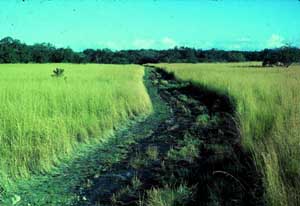|
|
 21 fire breaks DHJanzen100789.jpg high resolution
|
|
|
The basic method for stopping the fires in the ACG is to a) mow/burn fire breaks that can be used as the starting point for a backfire if they do not themselves stop the fire, b) maintain a publicity campaign locally (radio, talking) as to the damage done by free-ranging fires, c) aggressively go to a grass fire and quite literally beat it out with brooms and wet it out with backpack sprayers and motor driven pumps off a tractor-drawn water tank, and d) have the neighboring owners themselves less likely to set a fire because it threatens the woody vegetation (or newly planted trees) growing in their (now) abandoned cattle pastures as they seek other forms of livlihood. But, no matter how thorough the effort, there are still occasional fires through vandalism and carlessness. The ACG fire program puts out 30-70 fires per year. Does this have to go on forever? No, because the longer the grassy area goes without fire, the more thoroughly the forest invades. Gradually there is less and less herbaceous fuel that dries well in the dry season (but this gradual reduction is highly heterogeneous in space and time, and generally the better the soil, the faster the site returns to forest). Eventually the forest becomes close to unburnable, and small accidental fires can be easily extinguished. This particular fire break, burned in late December 1985 before the forest restoration process began, separates an area to be allowed to restore its forest (on the left) from an area that is being burned annually to keep it like it was (on the right), as a reminder of the past when this area was all cattle pasture. Today, this is called the Guacimal fire plot and see image DHJanzen100806.jpg below. |
||
back to lecture slides
or skip to: